
|
Greatest Scariest U-Z |
| Movie Title/Year and Brief Scene Description | ||||||||||||||||||||||||||||||||

|
The Vanishing (1988, Neth/Fr.) (aka Spoorloos) #55 This original film masterpiece, a psychological chiller from director George Sluizer, was based upon the novella The Golden Egg. In this unnerving tale, a Dutch couple were vacationing in France:
At a French roadside gas station, Saskia suddenly and mysteriously vanished - about 15 minutes into the film. Later it was shown, in flashback, that middle-class chemistry teacher, and sociopathic kidnapper Raymond Lemorne (Bernard-Pierre Donnadieu) was at a vending machine to buy drinks inside the truck-rest stop, next to Saskia. He lured her to his car - she sat in the front seat after seeing a picture of his family (believing that he was respectable and harmless). He discreetly poured chloroform into a handkerchief, and applied it to her face. She struggled against him, but then passed out. Haunted by the curious, obsessive need to find his missing girlfriend, Rex spent three years on a frantic search for her. He eventually came face-to-face with her abductor, who had devised a similar hideous fate for him. Rex was also targeted by Lemorne, who realized that he could commit an ultimately more evil crime. Raymond promised Rex that after he drank some spiked coffee, he would experience what happened to his girlfriend. In the shocking, heart-stopping ending, Rex woke up in pitch darkness. He found himself buried alive in a cramped coffin under the earth, with only a cigarette lighter for brief light. He discovered that he was claustrophobically entombed alive. He cried out: "Help! Help! Help!...Saskia!" He dug with his fingers at the few seams he could find in his coffin, before realizing that his lighter was about to go out forever.
The dwindling light of the flame became a tunnel through which he saw Saskia. Newspaper headlines in the back seat of Raymond's car told about a Mysterious Double Disappearance - of both Saskia and Rex. |
 Saskia (Johanna Ter Steege)  Kidnapper Raymond Lemorne (Bernard-Pierre Donnadieu)  Chloroforming of Saskia in Car |
||||||||||||||||||||||||||||||

|
#6 Hitchcock's film was a romantic suspense/thriller about a macabre, doomed romance - a desperate love for an illusion. It followed a troubled man's obsessive search to end his vertigo (and the deaths that resulted from his 'falling in love' affliction). The thriller became a masterful study of romantic longing, identity, voyeurism, treachery and death, female victimization and degrading manipulation, the feminine "ideal," and fatal sexual obsession for a cool-blonde heroine. The dizzying trick camerawork (a reverse zoom, dolly-out) visualized the vortex of vertigo and acrophobia (fear of heights) in the film's opening shots and in the bell tower scenes. Acrophobic obsessed and retired SF police detective John "Scotty" Ferguson (James Stewart) slipped into a surrealistic world of obsession, confused by the real and the imaginary. In one of filmdom's best 'identity-switch' plot twists ever invented (although revealed to the audience before the main protagonist), Scotty fell in love with the blonde, ethereal Madeleine Elster (Kim Novak), the suicidal wife of his old school friend Gavin Elster (Tom Helmore). As it turned out, Elster had hired a red-headed shop-girl named Judy Barton (also Kim Novak) to impersonate his blonde wife, and act suicidally "haunted" in front of Scotty. It was a ruse that worked, especially after Scotty pulled Madeleine from drowning in San Francisco Bay, and fell in love with her. When 'Madeleine' climbed a high Spanish mission bell tower to jump to her death, Scotty's vertigo prevented him from following closely behind. This was when Elster pulled the switch - after already murdering his 'real' wife (whom Scotty had never met), Elster dumped her corpse from the tower and made Scotty the perfect witness to her "suicide." Conveniently, Scotty never took a close look at the body.
The film cycled back on itself when Scotty ran across Judy - who bore an uncanny resemblance to the now-dead "Madeleine." After forcing her to look like his lost love, he realized that Judy was not Elster's wife but his mistress and they had meticulously planned his wife's murder. The key to solving her identity was a necklace. In the film's second terrifying sequence, Scottie dragged Judy Barton / Madeleine (Kim Novak) up the stairs to the top of the mission's bell tower to recreate the suicide. He confronted her about the first faked fall from the bell tower, orchestrated by her and Elster:
Judy anguished and pleaded for forgiveness, explaining how she willingly endangered herself by getting emotionally involved with him after the murder. With great sincerity and commitment, she professed that she still loved him even though he was her targeted victim:
Then, suddenly the footsteps of a black-clad figure in the shadows startled Judy. Judy backed away from Scottie gasping: "Oh, no!" The dark, shadowy figure said: "I hear voices." Terrified, thinking and believing she was seeing the ghost of the murdered Madeleine (or the reincarnation of the ghostly doomed mother Carlotta Valdes), Judy recoiled, stepped and fell backward through an opening in the tower and plummeted to her own death (off-screen) in an emotionally-shattering climax. She plunged off the tower -- and this time, her death was real! The figure, actually a nun from the mission, crossed herself and murmured the last words of the film: "God have mercy." The nun pulled the bell rope and rang the mission bell. As the bell tolled (signalling not salvation but eternal damnation), Scottie emerged from the arched window of the tower onto the belfry ledge. He stared down in horror at Judy's body far below - stunned, open-mouthed, shocked and glassy-eyed with his arms slightly away from his body. He was cured of his vertigo, but totally destroyed by his other delusions and burgeoning sorrow. Tragically loving and losing the same woman twice, repeating the pattern he had intended to break, the scene faded to black. |
 Vertigo Affliction  Scottie's Nightmares  Shopgirl Judy Barton (also Kim Novak)  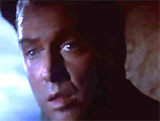 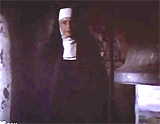 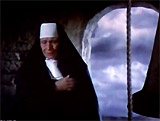 "God have mercy."   The Second Bell-Tower Sequence and Second Fatal Fall |
||||||||||||||||||||||||||||||

|
Videodrome (1983) #4 Director David Cronenberg's film was a terrorizing, hallucinatory tale of erotic sci-fi and "body horror." In the tale, the main character was sleazy cable TV station owner-director-producer Max Renn (James Woods) of X-rated CIVIC-TV Channel 83 in Toronto (in the 1980s), which aired soft-core pornography and sensationalistic, violent content. The TV CEO became enticed (and obsessed) by the broadcast signal of a pirated UHF TV show called Videodrome (from Malaysia?), which pushed the envelope on content - with torture and murder "snuff' films (not re-enacted as originally thought, but live and real!) in which people were actually tortured and killed. Renn ordered his technical colleague Harlan (Peter Dvorsky) to broadcast Videodrome on his own station (CIVIC-TV) without properly licensing the show. Professor Brian O'Blivion (Jack Creley), an optimistic and idealist thinker about mass media and pop culture, communicated only through TV broadcasts. He prophesied that television could replace 'real life' - he preached about a political movement that believed a better, quasi-spiritual life could be achieved through technological means:
However, there were a number of conspirators, members of a nightmarish cult, whose goal was to create marathon television watching (of extreme sex and violence) - to completely control and manipulate the masses. The effect of massive exposure to TV would produce fatal brain tumors in homeless "lowlifes" - and purge American audiences that watched such X-rated and violent fare, so that they would become docile, easily-led consumers. O'Blivion's daughter Bianca (Sonja Smits) was attempting to make her father's vision a reality. She led the Cathode Ray Mission - a large homeless shelter that provided 'healthy' doses of TV to destitute watchers. When O'Blivion learned of the malevolent and devious tactics of the growing political movement that took things to the extreme, he was killed (he was garrotted during one of his broadcasts by black-hooded radio host Nicki Brand (Deborah Harry), Renn's 'girlfriend'). He had become Videodrome's arch-enemy. Renn didn't know that he was being used by the villainous forces behind Videodrome - the Spectacular Optical Corporation (an eyeglasses company, and Videodrome's producer), headed by Chief of Special Programs Barry Convex (Leslie Carlson). Renn was deceived into watching (and becoming hooked on) Videodrome because Spectacular Optical (with the motto "Keeping An Eye on the World") wanted to seize and take over his Channel 83 TV station to broadcast its signal to the masses ("It can be a giant hallucination machine, and much much more!"). A mind-controlled Renn began to become infected due to his own TV watching (that seduced and controlled him), leading to his brain mutating and developing tumors, and he was experiencing many disturbing, mind-altering sights.
At the same time, Renn was being "counter programmed" by Bianca to murder the Videodrome people (fronted by Spectacular Optical):
Under the influence of the opposing forces, a "reprogrammed" Renn began to assassinate others, including both Harlan and Convex who wished to end the country's cultural decay (by inducing brain tumors in obsessed TV watchers):
In the film's conclusion, Max (with his own head filled with tumors) watched a videotaped TV show on a television set - his now-murdered and dead girlfriend Nicki told him that Videodrome had been weakened, but still needed to be defeated. She enticingly and seductively prompted him to shoot himself in the head to ascend to the next level and "leave the old flesh":
He watched the video as he blew his own head open - and the TV set exploded, with bits of his own intestinal flesh hurled into his living room. After being instructed about how to kill himself on videotape, Max imitated what he had just seen on the TV set, and followed Nicki's orders to evolve into the "new flesh." He suicidally shot himself with his own hand-gun, as he proclaimed: "Long live the new flesh." |
 Videodrome "Snuff" Torture  Professor O'Blivion (Jack Creley) - Speaking About Videodrome  O'Blivion's Executioner Nicki (Deborah Harry)  Slit in Abdomen   VCR in Abdomen   TV Enticement - Renn Kissing Giant Lips on TV Screen  Renn Was "Reprogrammed"  Renn's Literal Hand-Gun Used to Kill Harlan  How to Kill Oneself (1)  How to Kill Oneself (2) |
||||||||||||||||||||||||||||||

|
Village of the Damned (1960, UK) #92 Director Wolf Rilla's scary B-movie horror film (about an alien takeover) was loosely adapted from John Wyndham's 1957 sci-fi novel The Midwich Cuckoos. At the time of its release during the Cold War, the film functioned as an allegory for the Communist Scare of the 1950s. It was later remade as John Carpenter's Village of the Damned (1995). The tagline asked and warned:
In the film's opening during what was dubbed a "time out," a mysterious force-field caused everyone to collapse or fall asleep (and go unconscious) in the British village of Midwich during a mist. An impenetrable force field was established around the town. Later, it was discovered that the same phenomena of spawned mutant children occurred in other places around the world. When everyone awoke, every women of child-bearing age was pregnant, including unwed teenage girls and married women whose husbands were absent. There were many accusations of infidelity and premarital sex, although the children were virginally conceived. A group of twelve hyper-intelligent, telepathic, blonde-haired, unemotional, glowing-eyed kids (an alien race) with raised foreheads were born a few months later - (all at the same time). They were bonded to each other, group-minded ("One mind to the power of twelve"), and highly precocious.
There were odd instances involving the children:
Strange telepathic son David Zellaby (Martin Stephens) threatened one of the townsfolk: "There's nothing you can do to stop us. You have to be taught to leave us alone. Leave us alone!" The man's eyes bulged out of their sockets. In the film's tense conclusion set in the brick schoolhouse, resident scientist-teacher Professor Gordon Zellaby (George Sanders) faced-off against the deadly-staring, mind-controlling robotic children, including his own son. He struggled to maintain the image of the brick wall in his mind, to prevent the children from getting into his thoughts and learning that he had put a bomb in his briefcase sitting on the desk - timed to detonate at 8:30 and kill all of them, including himself:
After the bomb detonated, pairs of eyes drifted off into the sky, superimposed over the flames and smoke. The disembodied eyes hinted that they had survived the explosion. |
 Everyone in Midwich Rendered Unconscious  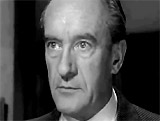    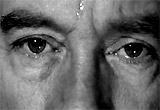  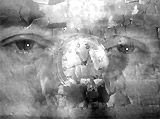 The Final Stand-off Between Professor Zellaby and the Robotic Children: "I Must Think of a Brick Wall"  Disembodied Eyes |
||||||||||||||||||||||||||||||

|
Wait Until Dark (1967) #10 Terence Young's suspenseful, Hitchcock-like crime thriller told about the deadly search for drugs, unknowingly stashed in a rag doll. The female-in-jeopardy film told about how a vulnerable blind woman named Susy Hendrix (Audrey Hepburn) was victimized by criminals who thought her ground-level Greenwich Village apartment held a missing doll. There were a number of shocking, scary moments, mostly in the nail-biting conclusion. As the film opened with the arrival of a plane from Montreal, Canada at JFK Airport, nervous heroin-smuggler Lisa (Samantha Jones) (with a rag doll stuffed with heroin) passed off the doll to a fellow passenger: professional photographer Sam Hendrix (Efrem Zimbalist Jr.), the husband of Susy. Lisa was intimidated by the sight of her psychotic and violent husband Harry Roat (Alan Arkin), after she had hidden and smuggled heroin inside the doll into New York City from Montreal, Canada. The doll (with drugs inside) was temporarily in the possession of Susy's helpful upstairs neighbor girl Gloria (Julie Herrod), before Susy later hid it inside her own ground-level Greenwich Village apartment. Lisa's two partners-in-crime were handsome and amiable two bit con-man/hustler Mike Talman (Richard Crenna) and his ex-cop partner Carlino (Jack Weston); they entered Susy's apartment where they expected to meet Lisa, but instead they found Roat, who offered them $2,000 dollars each to find the doll somewhere in the apartment. Then they made the gruesome and shocking discovery of Lisa's corpse hanging in a plastic garment bag in Susy's closet, after she had been murdered for her perceived double-cross by Roat. Roat then framed and blackmailed Talman and as Lisa's killers (their fingerprints were all over the apartment), unless they located the missing heroin. Suzy was quickly victimized by the three criminals during their relentless search for the rag-doll; they used every elaborate scheme and manipulative tactic they could think of (trick voices, multiple false identities or disguises, fake phone calls, etc.) to dupe and con the helpless Susy into revealing the doll's whereabouts (as "evidence" in a fictitious infidelity case implicating Susy's naive husband Sam with the murdered woman who originally owned the doll).Roat anticipated that he would be double-crossed by Talman and Carlino and so he murdered both of them; he ran over Carlino and then stabbed Talman in the back as he stood in Susy's doorway, before taking on the challenge of confronting Susy himself. In the final battle of wits inside Susy's claustrophobic apartment after Susy had smashed most of the light bulbs, she was confronted by Roat one-on-one, who coldly described how he had eliminated his partners, and how he wanted her to give up the doll. He put on plastic gloves, then stroked her face with a sheer nylon cloth:
When he suggested taking her to the bedroom (to rape or kill her?), she asked if he was looking at her: "Mr. Roat, are you looking at me?" - when he said he was, she tossed a vase full of flammable photographic hypo solution into his face.
She extinguished one of the last lights in the room, as he confronted her. Using all of her tactile skills, Susy retaliated by threatening to ignite his soaked body with a match. During the tense and chilling match-up between them, however, the cunning psychopath discovered the light in the refrigerator to illuminate the room (and put a towel in the door to prevent it from closing). Finally, Susy decided to hand over the doll - stashed in the bottom of her kitchen wastebasket, while she grabbed a long kitchen butcher knife for protection. Roat slashed open the doll and removed heroin packets, and then again suggested taking her to the bedroom. As he marched her across the room, she stabbed him in the abdomen. She retreated back to the living room where she found that her outer door was blocked. There was the exciting and extremely-scary jump-out-of-your-seat (or shock-leap) moment when the villainous, wounded and crazed Roat lunged with a knife from the dark bedroom hallway toward blind Susy. She screamed as he grabbed at her left ankle. He dragged himself across the floor using the knife blade, stalking her. She outwitted him by hiding behind the refrigerator door and pulling its plug, plunging her apartment into complete darkness. Would she survive his attack?
In the film's denouement, Susy's husband found her collapsed behind the refrigerator door - she slowly emerged alive. |
 Mike Talman Discovering Asphyxiated Lisa (Samantha Jones)  Villainous Roat (Alan Arkin) 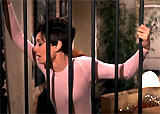 Susy Hendrix (Audrey Hepburn) 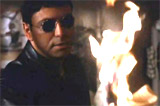 Terrorizing Susy With Fire  Susy: "Try lighting a match now, Mr. Roat!"   Roat Stabbed in the Abdomen  Susy Finding Outer Door Blocked  Susy Found In Film's Ending By Husband Sam Behind Refrigerator |
||||||||||||||||||||||||||||||
 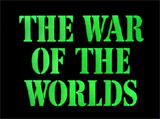
|
The War of the Worlds (1953) Paramount's Technicolored science-fiction, alien-invasion film from director Byron Haskin (and producer George Pal), loosely adapted from British author H.G. Wells' 1898 novel (of the same name), was about a Martian invasion of Earth, occurring in 1950s Southern California near Los Angeles. [Note: This was one of the things purists objected to, although other cities around the world were also affected.] It was an historically-interesting film, the grand-daddy of alien attack films, which won the year's Academy Award for Best Special Effects. The film was preceded in 1938 by Orson Welles' Mercury Theater on the Air radio version which shocked listeners who thought there was a real invasion occurring in Grover's Mill, New Jersey. In the film's opening, the commentator (Sir Cedric Hardwicke) explained how Martians wished to migrate to Earth, to colonize the thriving planet:
Meteorites landed in a California forest in the small town of Linda Rosa. When a trio of townsfolk approached the downed spacecraft with a white truce flag after the object's hatch unscrewed itself, they were vaporized by a blast from a tentacled, cobra-snake-like heat ray (or disintegrator beam) appendage, emanating from a sleek, hovering manta ray-like flying machine. Their remains were later viewed as patterned piles of disintegrated ashes. One of the most effective scenes was when pretty library science instructor Sylvia Van Buren (Ann Robinson) and handsome, bespectacled Dr. Clayton Forrester (Gene Barry), a vacationing Pacific Tech scientist, were caught in a partly-demolished abandoned farmhouse - after another cylindrical-shaped meterorite landed nearby, and three Martian war machines approached. A Martian electronic eye on a long, flexible cable failed to notice them when it inspected the interior of the ruined farmhouse. Sylvia had a scary farmhouse cellar encounter with an actual Martian creature which extended its creepy suction-cup fingered-hand onto her shoulder. The alien explorer was a hideous crab-like biped with a three-hued color television camera for an eye. She was defended by Forrester before they fled and the house was incinerated by the hovering war machine. The warring invaders began an assault on Earth, and destroyed everything that resisted - by employing protective force-fields. The dropping of an A-bomb was ineffective - one of the Martian flying machines, seen in a binocular view, emerged unscathed from a cloud of dust. One of the military generals, Maj. General Mann (Les Tremayne) was dismayed: "Guns, tanks, bombs - they're like toys against them!" Soon, Los Angeles was evacuated as the Martians were proceeding to conquer the world, and mobs of people panicked during their flight. Miraculously, the Martian flying ships collapsed throughout the world (and outside a church in SoCal where Sylvia and Clayton were reunited) and the aliens died - and the film ended in an uplifting scene with survivors standing on a hillside thankfully singing hymns. When the Martian threat fell prey to bacterial infection (an ironic twist), the commentator intoned (in voice-over) that God had saved humanity by "the littlest things."
|
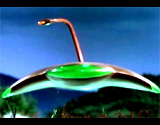 Floating Alien War-Machines 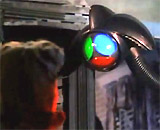
 Sylvia's Brief Glimpse of Martian  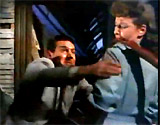 Sylvia's Scary Farmhouse Encounter with Alien Tentacle  Alien Explorer Close-Up  The Abandoned Farmhouse Incinerated  Assault on Los Angeles Suddenly Stopped 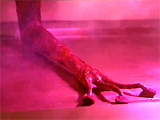  Death of Martian Creature - Attacks Suddenly Stopped |
||||||||||||||||||||||||||||||

|
When a Stranger Calls (1979) #28 The horror-thriller from director Fred Walton opened with the film's scariest sequence - about 23 minutes in length. Teenaged baby-sitter Jill Johnson (Carol Kane) suffered fearful torment as she received repeated anonymous phone calls (about every 15 minutes) from an unknown, lunatic assailant, who asked the same questions and then hung up:
She was somewhat assured that the windows and doors were locked. A call to the police led to this response: "It's probably just some weirdo. The city's full of 'em. Believe it or not, we get reports like this every night. It's nothing to worry about." She was told to find a loud whistle, and the next time there was a call to blow it loudly and break the caller's eardrum. And she was reassured that patrolmen were cruising the area. She attempted to dissuade the insistent caller during his final conversation:
When the phone went dead, she received another call - this time from the police, who issued a classic warning to her:
She frantically attempted to escape the house through the locked front door, as she looked back to the top of the stairs at a shadow of an intruder - when she finally was able to remove the chain lock and open the door, she came face to face (in a scary zoom) with a burly-faced man - not the caller but a police officer: Lieut. John Clifford (Charles Durning). Behind him were patrol cars with flashing lights. The Mandrakis' two children had been cold-bloodedly murdered (massacred!) several hours earlier and the disturbed serial killer Curt Duncan (Tony Beckley), an English merchant seaman, was found covered in blood. He had been using an old bedroom phone that had never been disconnected. Duncan was sent to an asylum, but escaped after six years of incarceration.
By film's end seven years later, Jill was now married with two children of her own. While out to dinner with her husband Stephen Lockhart (Steven Anderson), a reliable baby-sitter named Sharon (Lenora May) was tending to her children. Jill received another chilling phone call at the restaurant: "Have you checked the children...?" - she screamed:
However, everything was investigated and it appeared that nothing was wrong in her home. In the middle of the night, she awoke and went downstairs, then returned to bed after checking everything. After finding that the phone was dead, she heard a voice in the dark:
She turned on the light and tried to get her sleeping husband's attention. And to her horror, she discovered that the returning escaped killer was next to her in her own bed! She was grabbed and assaulted, but fortunately, Clifford (who suspected trouble after finding he was unable to call through) shot the killer dead (with two shots). A moaning Stephen was found alive but almost unconscious in the closet - Jill was assured: "Your husband's okay."
|
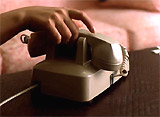   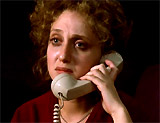  Repeated Calls Seven Years Later:  The Killer In Her Own Bed  Jill's Reaction   Killer Shot Dead Seven Years Later |
||||||||||||||||||||||||||||||
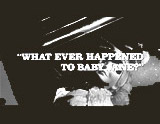
|
What Ever Happened to Baby Jane? (1962) This great psychological thriller, black comedy, and over-the-top camp classic featured the bizarre (and sole) pairing of two legendary -- and rival -- screen legends in a gothic, macabre, Grand Guignol horror film. The great trashy melodrama was directed by Robert Aldrich (known earlier for the great nihilistic film noir Kiss Me Deadly (1955)). The screenplay, by Lukas Heller, was based on Henry Farrell's 1960 novel Baby Jane (who also authored the novel Hush... Hush, Sweet Charlotte). The film opened with the two stars living together in a gloomy, crumbling mansion in Los Angeles in the early 1960s:
Pasty white-faced Jane, whose career faded long ago, was now a deranged alcoholic, and vengefully bitter and jealous toward her wheelchair-bound sister secluded in an upstairs bedroom. Enmity worsened when a local TV network aired a marathon tribute to Blanche Hudson movies, and Jane learned that Blanche was planning to sell the mansion and put her in a sanitarium. There were many stunning scenes and excessive performances, particularly Jane's relentless tormenting of her sister:
When the kindly
maid Elvira (Maidie Norman) found disabled Blanche in a
locked room, she confronted Jane with: "Give me that key!" (but
Jane wouldn't open the door) and then threatened to call the police.
When Blanche finally gave up the key, Elvira found Blanche tied
and gagged in the room, with her wrists suspending her in mid-air. |
 "Baby" Jane Hudson (Bette Davis) 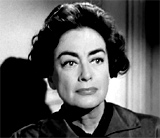 Blanche Hudson (Joan Crawford)  Dead Parakeet   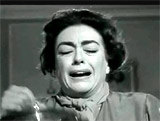  Baby Jane Serving Rat for Dinner  Baby Jane Had Been Practicing Forged Signatures |
||||||||||||||||||||||||||||||

|
The Wicker Man (1973, UK) #45 In this suspenseful and erotic horror-occult film, sexually-repressed and devoutly religious Scottish policeman Sergeant Neil Howie (Edward Woodward) searched for a missing young 12 year-old schoolgirl named Rowan Morrison (Geraldine Cowper) from an anonymous tip in a letter. He was led to the remote Scottish island of Summerisle owned by eccentric millionaire Lord Summerisle (Christopher Lee) to investigate the disappearance of the child. The townsfolk inhabitants living there were openly-sexual pagan worshippers who followed the teachings of their atheistic leader Lord Summerisle. Sgt. Howie believed (although wrongly) that the school girl was to be a potential virginal human sacrifice (the May Queen) on May Day, as part of a pagan ceremony to insure a good fruit harvest. While there, he was continually tested by their odd pagan practices and sexual behavior:
In the chilling finale of the cult classic, Howie learned that he was the one to be sacrificed. He was brought there to the island to be their pagan sacrifice, to appease the gods and to bring a plentiful fruit harvest. The 'missing' girl was never really missing - but had served as bait to lure him there. She had been part of Lord Summerisle's grand plan to bring him to the island and entrap him as the year's virginal fire sacrifice, after a disastrous harvest - a customary occurrence in the town's past history. As one of his earthly tests, Howie did not succumb to the fleshly temptations provided by the sexy innkeeper's daughter Willow MacGregor (Britt Ekland), who tried to seduce him in his Green Man Inn room next to hers on the second night of his visit before the May Day celebrations. Howie found himself apprehended and fooled, and told that he would be the perfect candidate: ("Animals are fine, but their acceptability is limited. A young child is even better, but not nearly as effective as the right kind of adult"). He was told he was the "unique" sacrificial subject that they needed for four reasons:
Howie learned that he was the one to be sacrificed to save the crops: ("You will undergo death and rebirth. Resurrection, if you like. The rebirth, sadly, will not be yours, but that of our crops"); he retorted back: "I am a Christian. And as a Christian, I hope for resurrection. And even if you kill me now, it is I who will live again, not your damned apples." Howie was told he was to be prepared for his sacrificial fate by being stripped and clothed in a ceremonial garment with his hands bound ("It is time to keep your appointment with The Wicker Man"); he protested his fate: "Don't you see that killing me is not going to bring back your apples?" (arguing that the crop failure was due to the climate and not the lack of a sacrifice), but the heathen leaders refused to listen to him, believing that their apple crop would be restored because of his sacrifice. He was led to a giant, hollow wicker-constructed figure of a man on a cliffside at sunset where he cried out ("Oh, my God!"). The 'wicker man' statue was created of wicker materials designed to be used for fire sacrifices - with compartments for live farm animals (pigs, ducks, calves, etc.). Lord Summerisle prayed to the "Mighty god of the Sun, bountiful goddess of our orchards. Accept our sacrifice and make our blossoms fruit."
He was horrified when he was locked inside the structure and the worshippers surrounded it (and sang a Middle English folk song with lyrics as it was set on fire: "Summer is a-comin' in, loudly sing cuckoo. Grows the seed and blows the mead, and springs the wood anew. Sing, cuckoo! Ewe bleats harshly after lamb, cows after calves make moo"). As Howie was consumed by the flames, he recited the 23rd Psalm ("The lord's my shepherd, I'll not want, He takes me down to lie in pastures..."), and prayed for deliverance. |
 Sgt. Howie in His Constable's Uniform  Photograph of Allegedly Missing 12 Year Old Rowan Morrison (Geraldine Cowper) 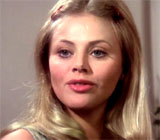 The Alluring Innkeeper's Daughter Willow MacGregor  Lord Summerisle (Christopher Lee)  Rowan Embraced by Lord Summerisle  Lord Summerisle to Howie: HE was the Perfect Sacrificial Candidate  Howie Protesting His Fate: "I am a Christian!"  Howie's First View of 'The Wicker Man' 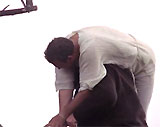 Howie Carried Into the Wicker Man Structure 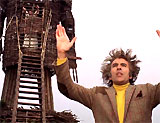 Lord Summerisle Praying: "Mighty god of the Sun..."  Flames Consuming the Structure |
||||||||||||||||||||||||||||||

|
Willy Wonka & the Chocolate Factory (1971) #74 This children's family film, a fantasy musical, was set in a fanciful land, Willy Wonka's (Gene Wilder) candy factory filled with orange-skinned, green-haired Oompa-Loompas workers. It had an unlikely scary scene for a family-friendly film. Tormenting, purple-clad Willy offered a boat ride down the Chocolate River to the kids and their parents, and promised:
Mr. Beauregard (Leonard Stone) was skeptical when he saw the upcoming tunnel: "I don't know, but I don't like the looks of that tunnel up there. Hey, Wonka, I want off!" Wonka kept ordering the rowers to go faster, as young Veruca Salt (Julie Dawn Cole) complained: "I don't like this ride, Daddy." Violet Beauregard (Denise Nickerson) also asked: "What is this, a freak-out?" While hallucinatory, colorful, hellish and surreal images (a slimy worm on a person's mouth, a beheading of a chicken, and a kaleidoscope of insects, etc.) were back-projected behind or next to them, Willy sat at the front of the boat, and provided strange commentary and eerie singing:
Suddenly, Willy ordered the boat to stop, and they arrived at their destination, the Inventing Room. |
      Chocolate River Boat Ride |
||||||||||||||||||||||||||||||

|
The Window (1949) Director Ted Tetzlaff's and RKO's dramatic film-noirish thriller was partly based on Cornell Woolrich's short story "The Boy Cried Murder" (adapted into a screenplay by Mel Dinelli). The premise of the gripping and truly scary B-film was that a young imaginatively-minded boy with fanciful stories in his head had 'cried wolf' so many times that no one believed him. The title screen included a quote from Aesop's Fables:
Similar remakes included:
In the opening scene, mischievous 10 year-old Tommy Woodry (Bobby Driscoll, Oscar-winner for outstanding Juvenile actor of 1949) unintentionally spread a rumor that his working-class parents on the Lower East Side of NYC, Ed (Arthur Kennedy) and Mary Woodry (Barbara Hale) were moving away. He was reprimanded harshly. On a hot and humid summer night, Tommy was given permission to sleep on an outdoor jungle-jim fire-escape, one floor above his own tenement apartment, and in the middle of the night, he witnessed a scissors-stabbing murder through a window committed by a ruthless couple, grifters Joe and Jean Kellerson (Paul Stewart and Ruth Roman). She was a hooker who lured men to their apartment, then gave them a knockout drug, and Joe would rob them and dump the bodies. Tommy had seen a grift gone wrong when they killed a drunken seaman (Richard Benedict). Every attempt by Tommy to speak to his doubting parents and the police-authorities increased the tension when his claims couldn't be substantiated, and they thought he was either dreaming or making up more stories. Their reasoning with him failed when they couldn't dissuade him from his accusations - all true, but unbelieved. There was a few tense sequences:
After Joe Kellerson successfully isolated Tommy in his apartment, his goal was to force him to confess what he knew, forcefully grab him, and then ultimately murder him by throwing him off a fire escape (and make it look like an accident). In the concluding chase sequence, Joe and Jean chased Tommy in a condemned building (where the body of the seaman was hidden), when the stairs collapsed and Joe fell to his death. Tommy's screams alerted the police when he became trapped on a beam, and he was forced to jump into a net to be rescued. A reunion with his concerned parents included words of encouragement from his father:
|
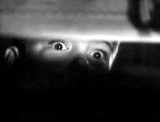 Tommy Witnessing a Scissors-Stabbing Murder of Drunken Seaman by Neighbors - The Kellersons   Tommy and His Parents  Intimidating Joe Kellerson (Paul Stewart)  The Kellersons with Tommy  Tommy Trapped on Beam |
||||||||||||||||||||||||||||||
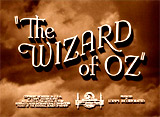
|
#86 Everybody's cherished favorite, perennial fantasy film musical from MGM during its golden years is The Wizard of Oz (1939). Lonely and sad Kansas farmgirl Dorothy Gale (Judy Garland) dreamt of a better place, without torment against her dog Toto from a hateful, cranky neighbor spinster named Miss Gulch (Margaret Hamilton) who had a court order to take her dog. So Dorothy ran away from home during a fierce tornado. She was struck in the head -- and in her dreams was transported to a land 'beyond the rainbow' where she met magical characters from her Kansas life transformed within her unconscious dream state. After travels down a Yellow Brick Road to the Land of Oz, and the defeat of the Wicked Witch of the West (also Margaret Hamilton), Dorothy and her friends were rewarded by the Wizard of Oz with their hearts' desires - and Dorothy was enabled to return home to Kansas. Many of the fantasy's scariest scenes involved the alter-ego of Miss Gulch - the cackling Wicked Witch of the West, who continually tormented Dorothy and her travel companions:
|
   Miss Gulch (Margaret Hamilton)    "I'll get you, my pretty - and your little dog, too! Ah-hah-hah-hah-hah-hah!"  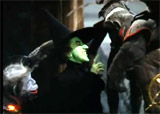  The Attack of the Winged Monkeys  The Witch Shocked When Grabbing the Ruby Slippers  "These things must be done delicately or you hurt the spell" 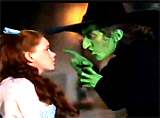
"You've been more trouble to me than you're worth..."  The Witch With the Hourglass Timer |
||||||||||||||||||||||||||||||

|
Wolf Creek (2005, Australia) #12 Director Greg Mclean's thriller was a somewhat repulsively-sickening, brutal and punishing film based on a true story (of a serial killer) and a very-deliberate throwback reminiscent of The Texas Chain Saw Massacre (1974). The film's opening legend was only semi-accurate, about the 'dark side' of the Australian outback:
A trio of stranded backpackers were threatened in the remote outback of Western Australia in 1999 on a three-week road trip from Broome to Cairns, Queensland via the Great Northern Highway:
At Wolf Creek National Park when they found that their watches stopped working (magnetic interference?) and their car was inoperable, the three were aided by a "Crocodile Dundee"- type local named Mick Taylor (John Jarratt), who turned out to be a sadistic, cruel, and brutal antagonist. At first, he made a show of fixing their car, and promised to tow their car for repair to his camp - an abandoned mining camp several hours south of Wolf Creek. He did so, but only after drugging them with tainted water and causing them to go unconscious - something he had done numerous times with other fated travelers through the region. The sadistic killer, gleefully enjoying every minute of causing pain, inflicted violent acts upon the group -- including kidnapping, rape, torture, and murder.
The three suffered gruesome fates: Liz was bound and gagged in a deserted shed, but able to escape; unexpectedly however, she was suddenly stabbed in the back through a car seat; Mick threatened her with his butcher-bowie knife when she pulled out her small Swiss Army knife - "That's not a knife. This is a knife!"; he dismembered or severed several fingers with one swipe of his knife, and then reassured her: "That's not gonna kill ya!"; Liz was also stabbed in the back - severing her spinal cord and rendering her paralyzed, while Mick described her as a "Head on a stick" as she lay motionless on the floor, aware and conscious but unable to move. Mick, functioning as a sniper with a hunting rifle, shot a passing motorist who stopped to help Kristy as she wandered onto the highway looking to escape; when she fled in the dead motorist's car, she was pursued; he blasted the vehicle, flipping it with a deflated back tire; when she appeared from the wreckage, Mick shot her, then put her body in the car's trunk and set it on fire. Ben was chained to the mine-shaft cave wall by his wrists, then hung (crucifix-style), with threatening, caged Rottweilers in front of him. However, he was able to eventually escape into the outback where he was found and airlifted to a hospital. There was no justice for the victims - in the final scene, Mick walked off, away from the camera, toward an outback sunset with his gun in his right hand - fading from view and ready to kill again. |
 Serial Killer Mick Taylor (John Jarratt)  Mick to Liz: "This is a Knife!"  Kristy Hailing Help From Passing Motorist on Highway  Motorist Shot by Sniper  Kristy Bloodied  Kristy Shot and Burned Inside Car  End Scene - Mick Walking Off After Menacing the Three Victims |
||||||||||||||||||||||||||||||

|
The Wolf Man (1941) #62 This was one of the greatest, classic horror films - a tense, well-made, eerie production, and one of the last of Universal's great monster films. Star Lon Chaney, Jr. would eventually star in a total of five werewolf films from 1941 to 1948.
Easy-going, innocent British heir Lawrence Talbot (Lon Chaney, Jr.) returned to Wales to the castle-mansion of his estranged father Sir John Talbot (Claude Rains), to be reunited with him after an education in America. Larry was set to run the vast Talbot estate. When he visited an antique shop and its pretty blonde antique shopgirl Gwen Conliffe (Evelyn Ankers), the daughter of the shop owner, he purchased a rare silver-topped, wolf-headed cane with a pentagram design - a symbol of the werewolf. She explained what a werewolf was:
Shortly after, at a gypsy festival attended by Larry, Gwen, and Gwen's girlfriend, beautiful young Jenny Williams (Fay Helm), Jenny had her palm read by traveling gypsy fortune-teller Bela (Bela Lugosi). Nearby was Bela's mother Maleva (Maria Ouspenskaya), another gypsy fortune teller - and the results were alarming (the image of a pentagram) - meaning she would be the werewolf's next victim.
Then, Talbot was bitten by a ravenous, hairy werewolf (also Bela Lugosi) when he attempted to save Jenny from being attacked in the throat by the beast on the moors (marsh). In her arms, Gwen comforted the wolf-bitten Talbot. Later, when the police investigated, they only discovered the bodies of Jenny and Bela (who had been beaten to death by the silver-topped cane that Talbot used as a weapon). In a chilling scene, gypsy mother Maleva told Talbot that he hadn't just killed any normal wolf: "Bela turned into a wolf and you killed him. A werewolf can only be killed by a silver bullet, or a silver knife, or a stick with a silver handle." She also informed Talbot that he was in danger. The bite was from no ordinary wolf - he had been bitten by the werewolf, and at each new full moon, he was now condemned like her son Bela was. She warned:
Talbot confessed to Gwen that the old gypsy woman told him: "She said that I was a werewolf." He offered his pentagram amulet to Gwen to protect her. Indeed, Talbot was fearful when he saw the fabled pentagram in the palm of Gwen's hand - a sign that she would be his next victim. In an amazingly-effective transformation scene (when the moon was full) (filmed with a series of lap dissolves), Talbot was transformed into a blood-thirsty creature with furry feet. There were shots of his legs growing hairier and hairier through dissolves, followed by the appearance of paws for feet. His first victim was a local gravedigger. In the final moments of the film, an atmospheric, exciting climax in fog-shrouded woods/swamp (during a full moon), Talbot's father Sir John joined a search party and bludgeoned the beast to death with the silver-tipped cane as it attacked Gwen on the moors, ending the man's suffering. After Talbot's body (transformed from a werewolf and reverted back to the human facial features of Talbot) was found at the site, he was praised as Gwen's heroic rescuer. The chief constable commented: "The wolf must have attacked her and Larry came to the rescue. I'm sorry, Sir John." However, Sir John looked on in horror, realizing that he had slain his own son. He cried out: "Larry!" |
 Gypsy Fortune-Telling Mother Mariva   The Chilling Foot Transformation Scene    Wolf Man's Attack on Gwen in Foggy Forest |
||||||||||||||||||||||||||||||

|
Zodiac (2007) #4 Director David Fincher's lengthy yet taut crime-drama thriller (with a script by James Vanderbilt), his sixth feature film, was a follow-up to some of his previous films, including the serial killer thriller Se7en (1995), Fight Club (1999) and Panic Room (2002). There have been numerous true-life (and dramatic) exposes about serial killers, including (to name only a few) Dirty Harry (1971) (inspired by the Zodiac case), Spike Lee's Summer of Sam (1999), Monster (2003) and The Hillside Strangler (2004). Fincher's Zodiac was the only one notably backed by a major studio. Fincher's very authentic, labyrinthine, complicated film, spanning 22 years from 1969 until 1991, was mostly a police procedural with fascinating characters - similar to the method taken in Alan J. Pakula's All the President's Men (1976) and Oliver Stone's JFK (1991). It meticulously followed the case (and Robert Graysmith's dogged and obsessive investigation also), in terms of sets, shooting locales, and costuming. Forensics experts and private investigators were hired to research the facts and study handwriting samples. There were references to the killer's interest in treating victims as prey, due to his mention of the short story The Most Dangerous Game, also a 1932 film. The actual Zodiac killer was involved in the shootings or stabbings of at least (probably more) seven individuals in four different attacks in the late 1960s, in the vicinity of San Francisco in Northern California. In three cases, the attacks were on couples, and in some cases there were survivors. The Zodiac became infamous for sending cryptograms and threatening letters to newspapers, notably the San Francisco Chronicle. He also took credit for other crimes (that he may or may not have committed), including the Cheri Jo Bates murder in Riverside in 1966 and the highway abduction of Kathleen Johns in 1970. The Zodiac's warnings first came in a letter to the newspaper ("This is the Zodiac speaking"), along with an encrypted note demanding that his missives be published or else he'd threaten with a larger killing spree - later, he said he would shoot out the tires of a school bus and then "pick off the kiddies as they come bouncing out." Although the random acts of violent manslaughter were often portrayed off-screen, there were a few scenes of the Zodiac's killings told with graphic detail, with the pained reactions of his victims (and the subsequent detailed discussion of their deaths by authorities). These were among the five killings the police felt sure that the Zodiac committed. In the opening blood-chilling sequence depicting the first two murders on the fourth of July, 1969 in Vallejo, CA Darlene Ferrin (Ciara Hughes) and Mike Mageau (Lee Norris) were in their car in a quiet park parking lot late that night. They were just "sitting, listening to music, talking". They noticed that they had been followed by a dark car from Mr. Ed's, but then it abruptly left. Mike asked Darlene: "Is that your husband?" - which she denied. She tried to reassure an increasingly-nervous Mike: "It's nothing."
But then, the car returned, parked behind them, and a mysterious hooded figure stepped out and shone a bright flashlight in their faces. After Mike joked: "Man, you really creeped us out," the killer raised his weapon (a 9 mm Luger) and began firing - the couple's bodies were riddled with bullets. The deaths were extreme, with spasms and spurting blood. Although the figure walked away, he returned and unleashed more bullets into the limp bodies - but Mike survived. In another equally horrifying, realistic sequence in broad daylight, another couple was picnicking by Lake Berryessa in Napa - law student Bryan Hartnell (Patrick Scott Lewis) and Cecelia Shepard (Pell James). A man dressed in black (with a zodiac symbol on his chest) approached with a gun, and demanded: "I want your money and your car keys." Bryan politely bargained with the man:
Then, the intruder ordered Cecelia to tie up Bryan, with rope that he provided. He came closer and threatened: "I killed a guard escaping from prison in Montana...I'm not afraid to kill again." He then tied Cecelia's hands behind her back, and told them: "I'm taking your car and going to Mexico." A knife (at close-range) was repeatedly plunged into Bryan's back, as his hog-tied girlfriend screamed and watched in horror next to him. Then, she was also knifed and twitched as she cried for help and died (reportedly, the "boy lived, the girl didn't" - with eight stab wounds to the back). Another murder was the shooting execution of cab driver Paul Stine (Charles Schneider) on a Presidio Heights street corner, after an aerial view of the taxi motoring through San Francisco at night. At the corner of Washington and Cherry, the Zodiac passenger committed the crime (one shot to the back of the head) while on a talk radio program (on the soundtrack), voices discussed the Zodiac phenomenon. The main crime reporter for the Chronicle in the case was neurotic, cocaine-using, hard-drinking, self-destructive, chain-smoking Paul Avery (Robert Downey Jr.), flamboyant and ineffectual, and two dedicated SFPD lead homicide detectives:
The Zodiac case ran into numerous bureaucratic snags and was officially unsolved. The SF Chronicle's editorial cartoonist, Robert Graysmith (Jake Gyllenhaal in the film), was also an author about true crimes (including two best-selling books about the Zodiac killer). After the official police case grew cold, the unassuming, Boy-Scout like, naive Graysmith began to obsessively conduct his own investigation. Although he found circumstantial evidence that couldn't be substantiated, he named Arthur Leigh Allen (John Carroll Lynch in the film) as the chief suspect.
In the film's most tension-filled scene that ended up in the basement of an old house, during the course of his investigation, Graysmith was speaking with Bob Vaughn (Charles Fleischer), and voiced his belief that the Zodiac may have been Rick Marshall, a silent-film projectionist. Vaughn was Rick's co-worker who played the organ at the same silent movie theatre. Graysmith hypothesized that Marshall had drawn some film poster advertisements that matched the Zodiac's handwriting. Graysmith panicked when Vaughn corrected him - Vaughn had drawn the ads ("Rick didn't draw any posters...Mr. Graysmith, I do the posters myself. That's my handwriting."). Creaking from upstairs floorboards caused Graysmith to fear death: "Are you sure there's nobody else in the house?" He backed up and fled upstairs to the kitchen door, that he found locked - causing more suspense in the sequence when he turned to find Vaughn behind him. The door was unlocked, and Graysmith fled into the rainy night. At the end of the film in a chilling scene, set in 1983, Graysmith stood face-to-face with the suspected killer, Arthur Leigh Allen, in a Vallejo Ace Hardware store, where he was employed as a sales clerk. |
|
||||||||||||||||||||||||||||||

|
Zombie (1979, It.) (aka Zombi 2, or Zombie Flesh Eaters) #98 This gory Lucio Fulci horror-sci-fi film was one of many Italian redos (or unofficial sequels) of George Romero's Dawn of the Dead (1978) (released in Italy as Zombi). Therefore, this one was alternately titled Zombi 2. The film opened with an eerie scene as an abandoned yacht-ship (un-manned except for one fat, bald, deformed flesh-eating zombie) (a rip-off of Nosferatu (1922)) entered NY harbor, and threatened to collide with other vessels in the area. One of two harbor Coast Guard patrolmen investigating the strange vessel was attacked below deck by a flesh-eating zombie and bloodily bitten in the neck. The second patrolman riddled the zombie's body with bullets when it didn't heed his warnings to "freeze where you are", and it tumbled into the water. During an investigation by police into the death of the patrolman from the zombie's attack, two people became involved in the case:
Anne told investigating police that she hadn't heard from her father in over a month, and last spoke to him 3 months earlier - when he set sail for the Antilles. (Her father first came out to the islands three years earlier.) Together with Peter West who was conducting his own investigation, they discovered a note written by her father to her from the island of Matul in the Antilles. He expressed gloom about his prognosis: "But I know I'll never leave this island again, at least not alive." There appeared to be a plague of zombie attacks on the island, causing the rampant contagious disease.
After arriving in the Caribbean's Antilles by plane, Anne and Peter hired a couple (two American guides) to provide them with a boat ride to the island of Matul: Bryan Curt (Al Cliver), an ethnologist, and Bryan's sexy wife Susan Barrett (Auretta Gay). However, they were explicitly warned: "That's not a cool place to head. Natives claim it's cursed. They avoid it like the plague." During the trip to the voodoo-worshipping Caribbean Island, Susan decided to go scuba diving without her bikini top. During her underwater excursion, she was attacked first by a tiger shark, and then a zombie. She fought off the zombie with a sharp piece of coral - who then took a big bite out of the shark, until the shark grabbed the zombie's arm and tore it off.
Meanwhile on the disease-stricken island during a plague, the suspicious Dr. David Menard (Richard Johnson), an expert on zombie reanimation (through miraculous voodoo), lived with his estranged wife Paolo (Olga Karlatos). She considered his research experiments "crazy, demented, cruel, evil...You're no better than one of their witch doctors....You call fooling around with superstitions and voodoo rites research?" She was desperate to leave the island as soon as possible, although communications were cut off. In one of the most gruesome and scary eye gouging or 'splinter-into-the-eye' death sequences ever filmed, Paolo was at first seen taking a shower, when a creepy zombie hand emerged at the bathroom window as it spied on her. When she realized she was being assaulted, she squished the zombie's fingers in her door, locked it, and then hid behind it to avoid the undead, marauding flesh-eating zombie from attacking. With great effort and exertion, she struggled to push a large, heavy cabinet over to the locked door to try and blockade it, as it was being splintered.
Through gaping slats in the broken-down door, the zombie reached in and grabbed her by the hair. It slowly dragged her right eyeball into a serrated shard of wood sticking out - horrifyingly filmed from her POV. After her death (off-camera), she was consumed by zombies. .
Dr. Menard came upon the stranded group from the boat, and told Anne about his acquaintance with her father David, and his recent death: "When he became a victim of the disease, he insisted upon staying, in spite of everything I said to him. I insisted that he should leave, but he wouldn't. He felt that he could, in some way, become a guinea pig. That he could help in discovering what was causing the horrors that were destroying our island, transforming it into a wasteland of terror. Extremely courageous man." There was a brief flashback to the day that David died when he begged Dr. Menard: "Make sure that my soul rests in everlasting peace." Shortly later, Menard reluctantly "released" his soul by shooting his wrapped body in the head - as he became zombified and came back to life. Menard regarded the phenomenon as the result of a voodoo curse: ("It makes the dead stand up and walk. I've seen it with my own eyes...Some evil witch doctor who creates these zombies"), but others were skeptical, especially Bryan: "Voodoo is just plain superstitious horses--t." Dr. Menard was determined to find if there was a "natural explanation."
After the boat group was sent back to Menard's cottage to check on his wife Paolo, they discovered her corpse being consumed by zombies. The group fled in a Jeep from the ravenous zombies, and ended up in the jungle near a Conquistador-era graveyard. Susan was attacked and bitten by a zombie-conquistador who had burst from the ground in the cemetery.
In the film's blood-splattered climax, the horde of flesh-eating zombies (many of which were Spanish conquistadors, evidenced by their helmets and rising from their gravesites) as well as "living dead" who were reanimated in the hospital, attacked the few human survivors on the island in a siege of the hospital's church similar to the one in Night of the Living Dead (1968). Dr. Menard was bitten in the face by one of his own reanimated patients. Fire-bombs worked temporarily to hold back the surge, but the only sure way to eliminate a zombie was to shoot it in the head. Bryan didn't defend himself when he was startled to see his own zombified girlfriend Susan, and she bit him in the left arm. Bryan commanded for Peter to shoot her in the head. Those who were able to get off the island included Anne, Peter, and Bryan (although he soon died from Susan's bite). Peter suggest that they lock Bryan up in the bilge to be brought back: "He's the only proof we've got that this all happened. And we will need proof unfortunately. Otherwise, they'll just think that we're crazy." In an ironic twist ending (similar to the film's opening), as their boat approached NYC harbor, a radio broadcast reported that the city was under a zombie attack: "The situation here in New York City since the discovery of the first zombie is getting worse by the hour. There's chaos in the streets...the zombies are taking over. The governor has declared a state of national emergency...The zombies are everywhere. There seems to be no way to stop them. The city is at their mercy." |
 Abandoned Sailboat in NYC Harbor  Attacking Zombie on a Deserted Yacht  Murdered Coast Guard Harbor Patrolman - Lethally Bitten in Jugular Vein  Zombie Riddled With Bullets  Bare-top Scuba Diving by Susan  Underwater Zombie Attack on Susan  Zombie vs. Shark   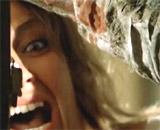 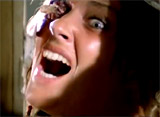  Paolo's Actual Eye Gouging  The Boat Group  Dr. Menard With the Stranded Group  Flashback: The Day Anne's Father David Died of the "Disease"  Anne's Father's Body Wrapped and Shot in the Head as It Zombified  Zombie Apocalypse: Night of the Living Dead-Styled Siege on the Island
|
||||||||||||||||||||||||||||||
(alphabetical by film title, illustrated) Intro | #s-A | B | C-1 | C-2 | D-1 | D-2 | E | F | G | H I-J | K-L | M | N-O | P | Q-R | S-1 | S-2 | S-3 | T | U-Z |